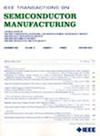实现光刻数字孪生的模拟与实验定量比较
IF 2.3
3区 工程技术
Q2 ENGINEERING, ELECTRICAL & ELECTRONIC
引用次数: 0
摘要
半导体制造工艺的数字图像为优化物理布局和纳米制造工艺设计、研究预期结构与工艺流程之间的兼容性提供了手段,也为分析最先进的 CMOS 和 MEMS 器件的缺陷根源提供了途径。本文定义了 CD-SEM 图像可视化结构之间几何差异的度量标准,并开发了一种基于计算机视觉的算法来评估该度量标准。此类指标的主要用途之一是比较实验图像和模拟图像。在此应用中,模拟器为 SEMulator3D®,这是一种基于物理的半导体和微机电系统(MEMS)设备工艺建模软件系统。计算机视觉工具,如滤波器、阈值处理和形态学操作,用于从 CD-SEM 图像中提取几何特征,并使用模式匹配和对称差分来计算度量。文中举例说明了如何使用这些指标来量化模拟纳米结构与制造纳米结构的 CD-SEM 实验图像之间的几何相似性。数据包括定义的八类纳米结构,在无尘室中以 36 种布局参数组合进行制造,并用 CD-SEM 进行成像。本文章由计算机程序翻译,如有差异,请以英文原文为准。
Quantitative Comparison of Simulation and Experiment Enabling a Lithography Digital Twin
Digital twins of the semiconductor fabrication process provide means for optimization of the physical layout and nanofabrication process design, studying compatibility between desired structures and a process flow, and a pathway to analyze the root causes of defects for state-of-the-art CMOS and MEMS devices. In this paper, a metric for the geometric differences between structures visualized by CD-SEM images is defined, and a computer-vision-based algorithm is developed to evaluate the metric. One of the major uses of such metrics is to compare experimental and simulated images. For this application, numerical results are presented when the simulator is SEMulator3D®, a physics-based process modeling software system for semiconductor and MEMS devices. Computer vision tools, such as filters, thresholding, and morphology operations, are used to extract geometric features from CD-SEM images and pattern matching and symmetric difference are used to compute the metric. Examples of using the metrics to quantify the geometric similarity between a simulated nanostructure and an experimental CD-SEM image of the fabricated nanostructure are presented. The data consists of eight classes of nanostructures which are defined, fabricated in the cleanroom with 36 combinations of layout parameters, and imaged with a CD-SEM.
求助全文
通过发布文献求助,成功后即可免费获取论文全文。
去求助
来源期刊

IEEE Transactions on Semiconductor Manufacturing
工程技术-工程:电子与电气
CiteScore
5.20
自引率
11.10%
发文量
101
审稿时长
3.3 months
期刊介绍:
The IEEE Transactions on Semiconductor Manufacturing addresses the challenging problems of manufacturing complex microelectronic components, especially very large scale integrated circuits (VLSI). Manufacturing these products requires precision micropatterning, precise control of materials properties, ultraclean work environments, and complex interactions of chemical, physical, electrical and mechanical processes.
 求助内容:
求助内容: 应助结果提醒方式:
应助结果提醒方式:


